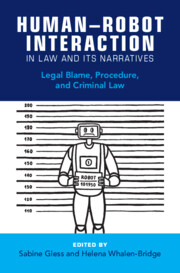
-
Select format
-
- Publisher:
- Cambridge University Press
- Publication date:
- October 2024
- August 2024
- ISBN:
- 9781009431453
- 9781009431507
- 9781009431484
- Creative Commons:
-
This content is Open Access and distributed under the terms of the Creative Commons Attribution licence CC-BY-NC 4.0.
https://creativecommons.org/creativelicenses - Dimensions:
- (229 x 152 mm)
- Weight & Pages:
- 0.75kg, 412 Pages
- Dimensions:
- (229 x 152 mm)
- Weight & Pages:
- 0.596kg, 414 Pages
- Subjects:
- Criminology, Law, Law and technology, science, communication, Sociology
Open AccessYou have access to this book- Subjects:
- Criminology, Law, Law and technology, science, communication, Sociology
Book description
Robots are with us, but law and legal systems are not ready. This book identifies the issues posed by human-robot interactions in substantive law, procedural law, and law's narratives, and suggests how to address them. When human-robot interaction results in harm, who or what is responsible? Part I addresses substantive law, including the issues raised by attempts to impose criminal liability on different actors. And when robots perceive aspects of an alleged crime, can they be called as a sort of witness? Part II addresses procedural issues raised by human-robot interactions, including evidentiary problems arising out of data generated by robots monitoring humans, and issues of reliability and privacy. Beyond the standard fare of substantive and procedural law, and in view of the conceptual quandaries posed by robots, Part III offers chapters on narrative and rhetoric, suggesting different ways to understand human-robot interactions, and how to develop coherent frameworks to do that. This title is also available as Open Access on Cambridge Core.
Contents
Full book PDF-
Human–Robot Interaction in Law and Its Narratives
pp i-ii -
-
- You have access
- Open access
- HTML
- Export citation
-
-
Copyright page
pp iv-iv -
-
- You have access
- Open access
- HTML
- Export citation
-
-
Dedication
pp v-vi -
-
- You have access
- Open access
- HTML
- Export citation
-
-
Contents
pp vii-ix -
-
- You have access
- Open access
- HTML
- Export citation
-
-
Contributors
pp x-xiv -
-
- You have access
- Open access
- HTML
- Export citation
-
-
Foreword
pp xv-xvii -
-
- You have access
- Open access
- HTML
- Export citation
-
-
Acknowledgments
pp xviii-xix -
-
- You have access
- Open access
- HTML
- Export citation
-
-
Table of Cases
pp xx-xxiv -
-
- You have access
- Open access
- HTML
- Export citation
-
-
Table of Statutes
pp xxv-xxx -
-
- You have access
- Open access
- HTML
- Export citation
-
-
Table of Council of Europe Instruments
pp xxxi-xxxi -
-
- You have access
- Open access
- HTML
- Export citation
-
-
Table of Other Council of Europe Materials
pp xxxii-xxxii -
-
- You have access
- Open access
- HTML
- Export citation
-
-
Table of European Union Instruments
pp xxxiii-xxxiv -
-
- You have access
- Open access
- HTML
- Export citation
-
-
Table of Other European Union Materials
pp xxxv-xxxv -
-
- You have access
- Open access
- HTML
- Export citation
-
-
Table of Other Materials
pp xxxvi-xxxvi -
-
- You have access
- Open access
- HTML
- Export citation
-
-
Abbreviations
pp xxxvii-xl -
-
- You have access
- Open access
- HTML
- Export citation
-
-
Introduction
pp 1-2 -
-
-
- You have access
- Open access
- HTML
- Export citation
-
-
Part I - Human–Robot Interactions and Substantive Law
pp 3-86 -
-
- You have access
- Open access
- HTML
- Export citation
-
-
1 - The Challenges of Human–Robot Interaction for Substantive Criminal Law
pp 5-22 - Mapping the Field
-
-
-
- You have access
- Open access
- HTML
- Export citation
-
-
4 - Forms of Robot Liability
pp 73-86 - Criminal Robots and Corporate Criminal Responsibility
-
-
-
- You have access
- Open access
- HTML
- Export citation
-
-
Part II - Human–Robot Interactions and Procedural Law
pp 87-278 -
-
- You have access
- Open access
- HTML
- Export citation
-
-
5 - Introduction to Human–Robot Interaction and Procedural Issues in Criminal Justice
pp 89-110 -
-
-
- You have access
- Open access
- HTML
- Export citation
-
-
7 - Principles to Govern Regulation of Digital and Machine Evidence
pp 141-166 -
-
-
- You have access
- Open access
- HTML
- Export citation
-
-
9 - Digital Evidence Generated by Consumer Products
pp 193-220 - The Defense Perspective
-
-
-
- You have access
- Open access
- HTML
- Export citation
-
-
10 - Data as Evidence in Criminal Courts
pp 221-252 - Comparing Legal Frameworks and Actual Practices
-
-
-
- You have access
- Open access
- HTML
- Export citation
-
Metrics
Altmetric attention score
Full text views
Full text views help Loading metrics...
Loading metrics...
* Views captured on Cambridge Core between #date#. This data will be updated every 24 hours.
Usage data cannot currently be displayed.
Accessibility standard: Unknown
Why this information is here
This section outlines the accessibility features of this content - including support for screen readers, full keyboard navigation and high-contrast display options. This may not be relevant for you.
Accessibility Information
Accessibility compliance for the PDF of this book is currently unknown and may be updated in the future.


